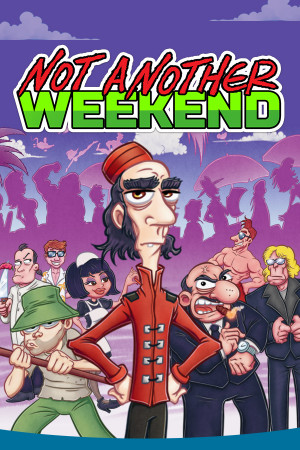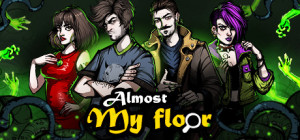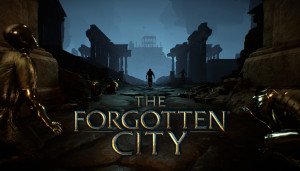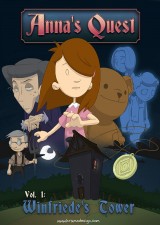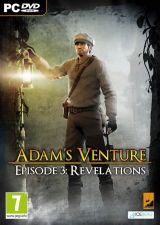Review for Last Stop
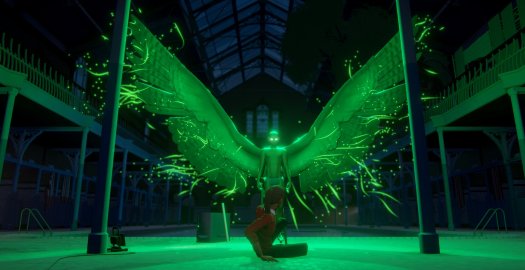
I consider myself a die-hard classic point-and-click adventure gamer, but every once in a while I encounter a game that challenges me to broaden my horizons, and Last Stop is one of them. The new title from the creators of Virginia has almost no inventory, no real puzzles to solve, and no consequences to your actions or dialog choices (except at the very end). Even exploration of your surroundings is tightly controlled. Yet I really enjoyed playing through its three seemingly separate but engrossing stories of intimate personal drama across a larger narrative arc of intergalactic importance with increasingly heightened stakes. While I would have appreciated more to actually do, or at least a greater sense that I was in control, the strong writing, high production values and large cast of well-developed (and equally well-voiced) characters prove those elements are not necessary to create an enjoyable story-driven experience.
The game begins in 1982 London, with two teenagers (Peter and Samantha, or Sam for short) being chased through the Tube by bobbies for stealing one of their hats. The pair flee via a doorway down one of the tracks and encounter a strange man, who tells them that they are late. Confused, they decide to work with this stranger as it appears he can help them escape. He leads them to another door that opens to strange, swirling, bright green lights. Sam decides to go through and disappears, with the stranger following. Peter hesitates, and the door closes. When the policemen catch up and open the door, there is just a brick wall behind it. Sam has disappeared with no apparent way to find her.
We then jump to present day, with three people riding on a subway car, each representing an interesting story with its own title: “Paper Dolls” (John Smith, a balding middle-aged man), “Domestic Affairs” (Meena Hughes, a serious-looking professional), and “Stranger Danger” (Donna Adeleke, a young black woman listening to music on her headphones). Each story is spread over six chapters, and you can choose which to tackle in any order you like. Once you select a character, however, you must finish their current chapter before returning to the train to pick the next passenger for their corresponding chapter. In this way you’ll alternate between the three characters chapter by chapter throughout the game until a final chapter pulls them all together in an engrossing sci-fi finale that spans multiple worlds and the fates of all involved, including the missing Sam.
I decided to start with Meena. Surprisingly, the voice-acting credits for all three stories roll at the beginning of each, giving the introductions something of a movie-like feel. Meena’s story sees her competing for a new assignment at work while also having an affair and dealing with complicated relationships with her husband and young son. As you learn more about Meena, it’s hard not to find her a very unlikeable character, but certainly an accomplished and dedicated one in her career as a Special Ops veteran now serving as an operative for a secret government agency. It’s this strength of character that will prove to be all-important when she’s swept up into a crisis of cosmic consequences in the final chapter, which tests her mettle in ways that challenge her otherwise selfish tendencies.
Next I selected John, whose plot revolves around a strange incident in a subway station. Both John and his neighbour Jack are commuting when Jack bumps into a businessman, damaging his briefcase and Jack’s phone as it falls to the ground. The businessman is very angry and, holding both of their arms, uses a weird-looking bracelet and says, “You two were made for each other” before disappearing. The two are startled but think nothing of it. The next morning Jack wakes up in John’s body and vice versa! The rest of the storyline has Jack, John and Molly (John’s precocious young daughter) navigating life in these reversed roles while trying to figure out a way to undo this body transfer. The contrast between personalities is interesting, as John is a loving and caring father, while Jack is pretty self-centered. As the story unfolds, Jack, seeing the close relationship between John and Molly, begins to recognize the value of being part of a family himself.
Completing those two initial chapters left Donna, who is close to her family. Her sister Emma is a police officer engaged to a young woman named Aisling; her mother Tamara is very loving but becomes gravely ill, which becomes a motivating factor in the plot. Donna hangs out with close friends Vivek and Becky, with whom she spends more time than she should. This narrative revolves around a “Stranger” (also referred to as “the handsome man”). The three friends notice that he invites people into his apartment, but they never see anyone leave. Their curiosity gets the better of them, so they follow the Stranger to a swimming pool in an old, abandoned building and end up capturing him. The rest of the story involves figuring out who the Stranger is and why people keep disappearing from his apartment, which proves to be far more than the girls ever imagined.
Each story is very different in terms of plot, but they all involve deep emotional relationships and conflicts with friends and family that need to be resolved. Meena has a tense relationship with both her husband and son, and is pitted against a younger, more aggressive adversary looking to take over her job. She is also trying to protect her father from a young drug pusher and things get complicated. John and Jake need to cope with the challenge of pretending to be each other in their professional lives as well as taking care of Molly, who is dealing with the predicament as best she can. Donna must contend with what to do with the Stranger, keeping his captivity secret from her sister Emma, and facing severe medical issues with her mother. In all cases the writing is very good, moving each story along at a snappy pace while inching toward the inevitable convergence in the final chapter. Sharp-eyed players will likely detect a hint of overlap before then. For example, early on when John is waiting for a bus to arrive, you see Meena with her cellphone walking by in the background, and John’s daughter Molly is friends with Meena’s son Dylan.
Third-person movement is handled using the WASD keys (which is what I used) or the equivalent on a gamepad, with the camera perspective changing as you walk or run, sometimes over your shoulder and sometimes even from in front. All the locations you visit (except in the final chapter) are real-world areas in London, including Tube stations, buildings and parks. Each 3D scene is nicely enlivened with activity such as background traffic, pedestrians and wildlife, accompanied by appropriate sound effects. No setting is so large as to be difficult to navigate, not that you’re given the freedom to anyway. Many of the outdoor areas appear to be spacious and invite exploration, but they are in fact tightly controlled so that you are only able to travel a specific path. If you try to deviate you hit an invisible wall and are forced back to the prescribed route. I found this frustrating, as some of the side streets and back alleys looked interesting and I wanted to check them out. To make matters worse, some of the paths you need to traverse are quite lengthy and there is no way to speed up your pace (unless the game has you running, which only occurs in certain areas).
Unfortunately there are almost no puzzles to be solved either, with only one inventory item acquired late in the game. Occasionally you’ll engage in a Quick Time Event, such as alternately pressing the A and D keys when prompted to outrun the subway train at the beginning, but this ultimately serves only to give you a sense that you’re participating in the story without any influence over it. There are also several times when you’ll need to perform an action that is nothing but busywork. For instance, when John is having breakfast you need to use a combination of keys to get him to drink his juice and eat his cereal. This happens frequently enough to quickly become tedious. Other actions include mini-games such as trying to toss a bottle into specified targets by highlighting them and timing your mouse-click to stop inside a defined on-screen marker. If you fail at any of these tasks, there is no impact on the story but succeeding can provide a Steam achievement.
None of these activities amount to much of anything, though they do provide a break from the storytelling, which can be quite intense at times. Sadly the same lack of agency becomes apparent early on with the dialog options. You are always given three choices when input is required (there is a timer that will default to a reply if you take too long), but nothing you choose has any real impact. You may get a different response, but other than some Steam achievements there are no relevant consequences to your decisions. Many times the choices amount to mere variations on the same answer, so what is the point?
Graphically, Last Stop sits somewhere between cartoony high-resolution rendering and photorealism. Landscapes and buildings are crisp and clearly defined, while characters are similarly depicted with smooth animation, both while moving and during conversation. I was particularly impressed with the changing perspectives when characters travel from one location to another. The camera will often pan along with you as you walk and talk with other people. Shadows and lighting look realistic, and there are several scenes in which the foreground is smartly blurred when the focus is on something in the background, giving an authentic sense of depth. Overall I was very pleased with the presentation, as it works well in conjunction with the soundscape to create an immersive cinematic experience.
Voice acting complements the excellent writing as one of the real strengths of this game. Without exception, every actor knocks it out of the park, which is impressive given the number of characters involved. There are a total of 38 voiced roles performed by 24 actors, but I couldn’t tell that any actors performed multiple parts. Each voice matches each character perfectly, delivered with the right amount of emotion and personality. A perfect example is Jack, as he believably freaks out when he wakes up to discover he is in a different body. Though everyone is good, a particular standout is Molly, such as when she tells her dad that she managed to forge his signature so there’s no need to sign off on her homework, or reminds him that they are out of groceries. Very mature for an eight-year-old who finds herself thrust into an upsetting situation that demands she grow up far too soon.
Like the voice acting, the soundtrack is outstanding. And no wonder, as it was performed by the City of Prague Philharmonic Orchestra. The music perfectly fits the circumstances throughout the game: when moving around inside areas there is a definite Celtic feel with flutes and fiddle, while outside locations feature generic but pleasant background tunes heavy on piano and woodwinds. The final chapter has a lot of action and is far more emotionally charged. Effects are handled with equal care, with ambient sounds of rustling wind and changing footfall on different surfaces, not to mention the vortex-like rush of wind accompanying the green swirling lights of a portal between worlds.
There is no save game option, but your progress is automatically saved at checkpoints within each chapter, and of course when one is completed. Since each chapter can be finished within five to fifteen minutes (adding up to a total game time of around five hours), you’ll probably want to play each one to the end anyway, but at worst you’ll only need to replay a few minutes at most to catch up once you resume.
When you get to the climactic final chapter, you need to make one of two choices for each character based on their particular scenario, leading to six possible endings. After you have made your first decision and seen how things panned out for each character, you can restore the game to a point where you can try again to see the results of the alternate choices. While none of these outcomes are ideal for their respective characters, a few are better than others and provide more hope for their future. In my playthrough I made my decisions based on my assessment of the moral character of each protagonist, which I think was the intent of the developer, but I am sad to say that they resulted in what I consider the worse outcome each time.
Regardless of whether you consider it a true adventure game, I recommend everyone who enjoys a good story to take a close look at Last Stop. It lacks almost all of what would be considered the genre’s traditional gameplay elements, with no real puzzles and only limited exploration and interaction with the environment, but the slick production values and compelling tales of three families struggling with intensely dramatic issues in the face of a force they don’t understand tops all of that. While events may ultimately converge in a fantastical sci-fi storyline, the primary focus on characters makes it all surprisingly relatable, and by the end you’ll feel fully invested in the protagonists’ fates, though you’ll have to live with the consequences of your final decisions in how it all turns out.











